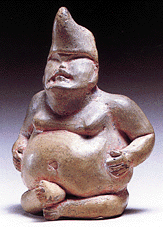
December 21, 2012
In terms of the Mayan revival, one more thought. What were the source of the little people depicted in art among the classic Mayans?
Flores people researcher Dan Gannon noted to me in 2009, “the Aluxob have been extensively and consistently documented and described, in Spanish-Mexican culture for more than 500 years.” Yet, as Gannon pointed out, some programs like Destination Truth incorrectly depicted them as small, hairy, fanged, wild beasts. The Aluxob never were recalled in those terms by the Mayans.
Simply put, the Alux hominids look like small humans, sometimes with clothing, but more often than not like rural, feral humans. They were Proto-Pygmies.
The Aluxob (plural Maya) are seen in the Yucatan, Mexico, mostly by the Mayans, but sometimes by Mexicans and United States tourists, quite regularly.
People in the Yucatan see the Aluxob, and when I was there in the 1980s, I was able to interview informants (mostly Mayans) who had firsthand sightings.

In my 1985 book, Curious Encounters, I devoted a chapter to the lore, legends, and legacy of these Little People in that corner of the world. Patrick Huyghe and I also dealt with the Alux in our The Field Guide of Bigfoot and Other Mystery Primates (2002, 2006). Harry Trumbore’s drawing in The Field Guide to Bigfoot and Other Mystery Primates shows a typical Alux with long hair and elementary clothing. But some of the stylized sculptures at Tulum (above) give a graphic illustration of the small 2-3 feet tall beings under the site’s tiny archways.
Doing a bit on research on “little people” art among the Mayans (fittingly, I pondered, for 12-21-2012), I found the following:

Mayan Dwarf, AD 550-850 (Late Classic)
Dwarfs were important members of royal Maya courts. They are portrayed serving food, playing musical instruments, holding sacred objects for the ruler, and as diviners and scribes. Their elevated social roles were steeped in cosmology and religious mythology, especially that of the maize god, who was assisted by a dwarf when the deity set the Three Stones of the cosmic hearth at the beginning of Creation. The Classic Maya viewed dwarfs as the living embodiment of the maize god’s supernatural helpers, who continued their sacred duty in the regal court. Maya peoples today believe that earlier creations were populated by a race of dwarfs who now reside inside the earth, living below the ruins of the ancient cities. The ornate turban worn by this dwarf is typical of the courtly garb of key individuals serving the ruler. This so-called spangled turban headdress is especially connected to gods and humans associated with Creation and scribal duties. A curious feature of this dwarf is what may be a halved cacao pod held in his right hand. His cheeks are covered with what appears to be a thin, woven fabric; this recalls other figurines, many of which are dwarfs, with an unidentifiable material plastered to the lower half of their face. These features suggest the depiction of a formal rite. The graceful rendering of this figure and the exceptional attention to detail reveal the work of a master artist. Source: Walter Arts Museum
Here, too, is a Yaxchilan ballplayer shown with two dwarfs.

Perhaps the Aluxob were captured by Mayans, enslaved, and made to serve as courtyard, ballyard, and other attendants?
How about among the Olmec?

Here is an Olmec dwarf.
Source.
Alux and Aluxob? Slaves? Perhaps.
About Loren Coleman
Loren Coleman is one of the world’s leading cryptozoologists, some say “the” leading living cryptozoologist. Certainly, he is acknowledged as the current living American researcher and writer who has most popularized cryptozoology in the late 20th and early 21st centuries.
Starting his fieldwork and investigations in 1960, after traveling and trekking extensively in pursuit of cryptozoological mysteries, Coleman began writing to share his experiences in 1969. An honorary member of Ivan T. Sanderson’s Society for the Investigation of the Unexplained in the 1970s, Coleman has been bestowed with similar honorary memberships of the North Idaho College Cryptozoology Club in 1983, and in subsequent years, that of the British Columbia Scientific Cryptozoology Club, CryptoSafari International, and other international organizations. He was also a Life Member and Benefactor of the International Society of Cryptozoology (now-defunct).
Loren Coleman’s daily blog, as a member of the Cryptomundo Team, served as an ongoing avenue of communication for the ever-growing body of cryptozoo news from 2005 through 2013. He returned as an infrequent contributor beginning Halloween week of 2015.
Coleman is the founder in 2003, and current director of the International Cryptozoology Museum in Portland, Maine.
Filed under Breaking News, Cryptotourism, CryptoZoo News, Feral People, Pop Culture, Proto-Pygmies